Abstract
The T lymphocyte insulin receptor model has been used to explore the regulation of insulin receptor appearance in that lymphocytes do not bear the insulin receptor in the circulation and thus are not amenable to regulation by virtue of ligand binding. Such cells synthesize insulin receptors when stimulated by antigen in vivo or in vitro. In these studies, the glucose clamp technique was employed to isolate perturbations in plasma glucose and plasma insulin as potential mediators of the regulation of the mitogen-induced T lymphocyte insulin receptor. Nondiabetic, normal weight individuals volunteered for 10 hyperglycemic clamp studies and nine euglycemic clamp studies with five individuals studied by both protocols. Hyperglycemia and hyperinsulinemia were created by the hyperglycemic clamp (basal plasma glucose was increased from 89 +/- 2 mg/dl to 230 +/- 2 mg/dl and an insulin of 99 +/- 8 microU/ml was reached). Blood was removed for isolation of T lymphocytes at 0, 1, 3, and 4 h of the clamped condition. After 1 h of hyperglycemia accompanied by an elevated plasma insulin, T cell insulin binding fell from 9.9 +/- 0.9 pg/10(6) lymphocytes to 8.5 +/- 0.9 pg/10(6), and reached a nadir of 19 +/- 4% at the conclusion of the clamp. Scatchard analysis of binding data from two of the subjects who underwent the hyperglycemic clamp demonstrated a reduction of the number of binding sites per cell without a change in the affinity of ligand for receptor. To separate the effects of glucose and insulin and the manner in which insulin is provided, the 4-h euglycemic clamp was performed in which fasting plasma glucose was maintained (95 +/- 2 mg/dl) while constant hyperinsulinemia was created (80 +/- 3 microU/ml). Insulin binding to activated, cultured T lymphocytes demonstrated a similar fall in insulin binding. Scatchard analysis of three additional studies again revealed a reduction in receptor number to approximately 40% of base line. These studies reveal that T cell insulin receptor regulation is achieved by hyperinsulinemia independent of the glucose level achieved. The reduction in insulin binding and receptor number could not be accounted for by variations in the strength of lectin stimulation, the time course of lectin response, or by the stress of the clamp itself. The effect of the clamp was specific for the lymphocyte insulin receptor in that the clamp had little effect on the interleukin II receptor activation marker. Acute changes in plasma insulin by the glucose clamp technique are perceived by the T lymphocyte and displayed in tissue culture by an alteration in lectin-induced insulin receptors. One can conclude that rapid changes in ambient in vivo insulin concentrations can regulate the synthesis of T lymphocyte insulin receptors generated in vitro.
Full text
PDF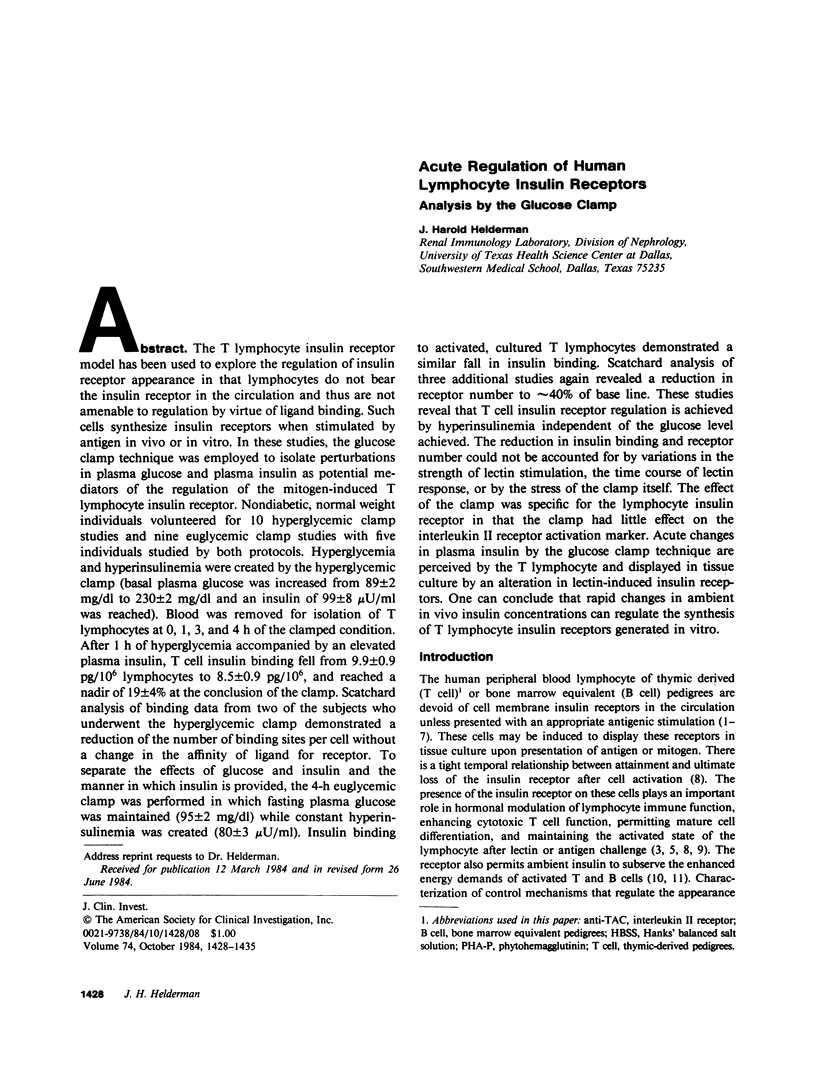
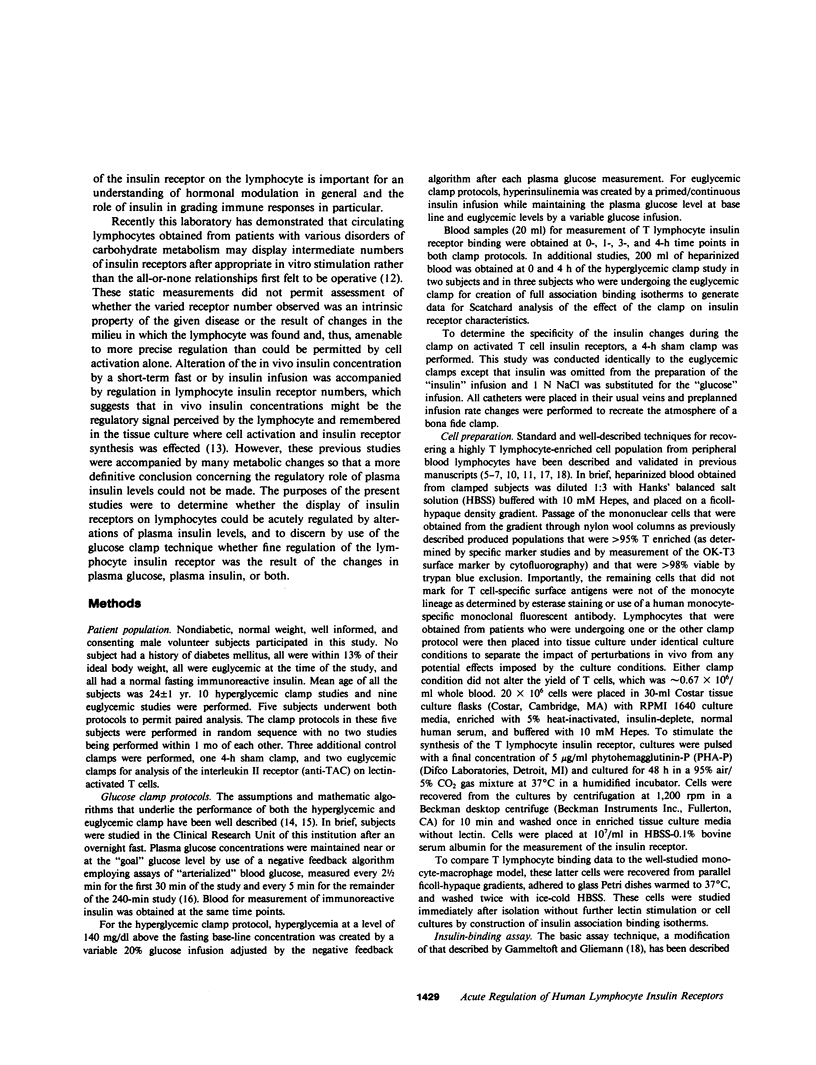
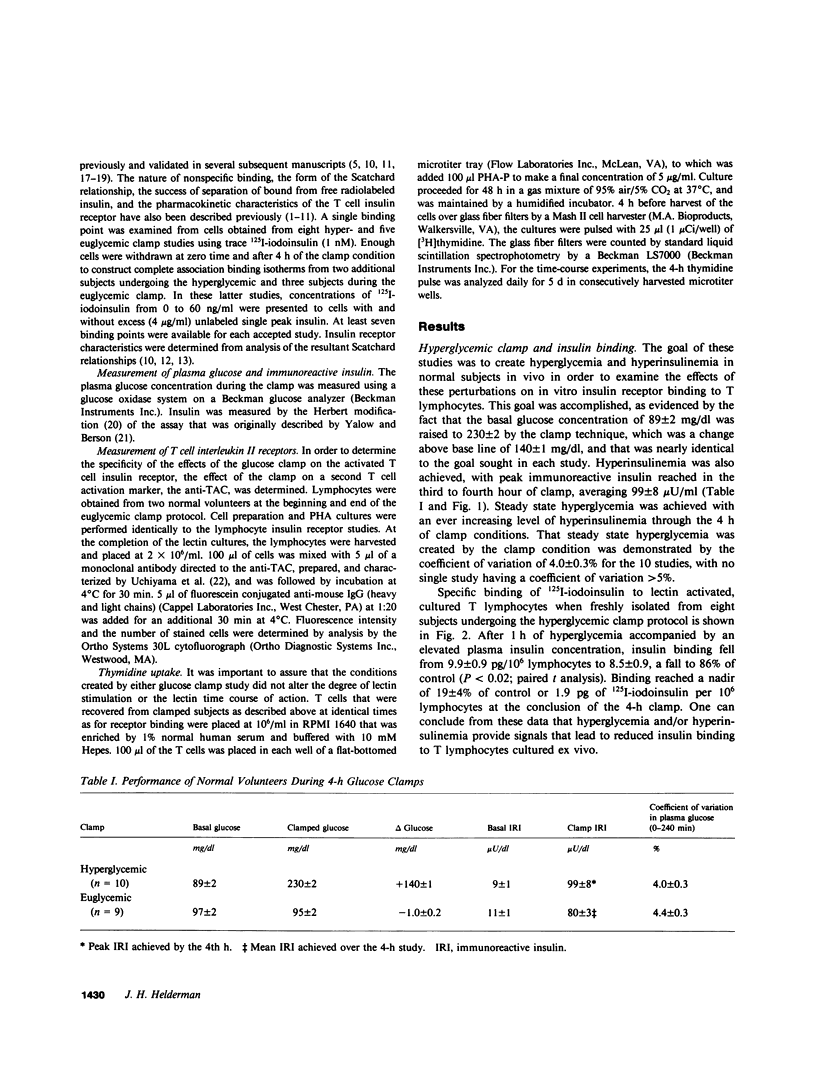

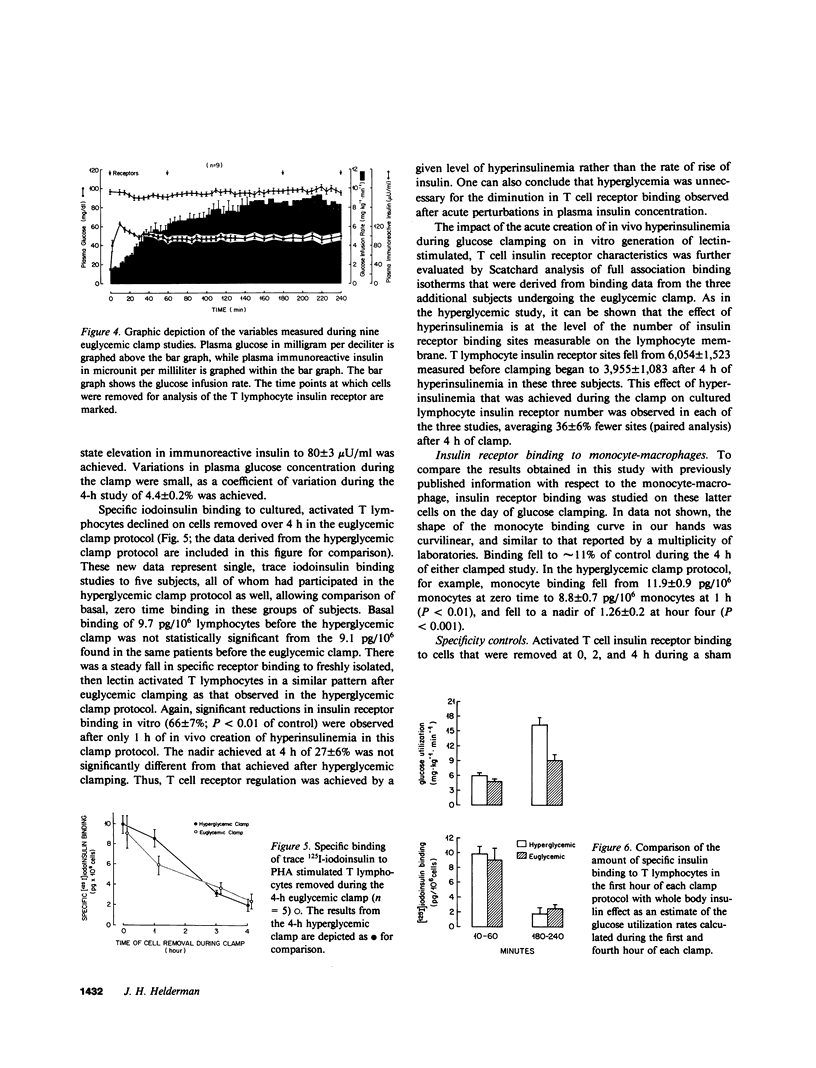
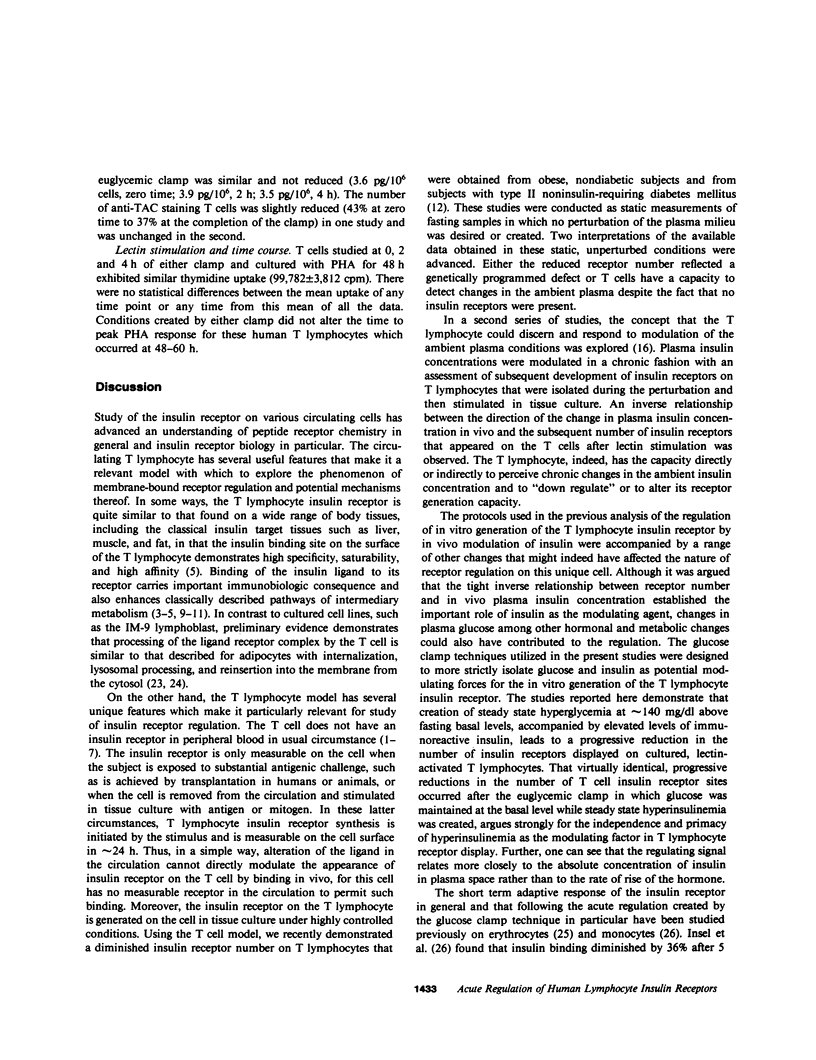
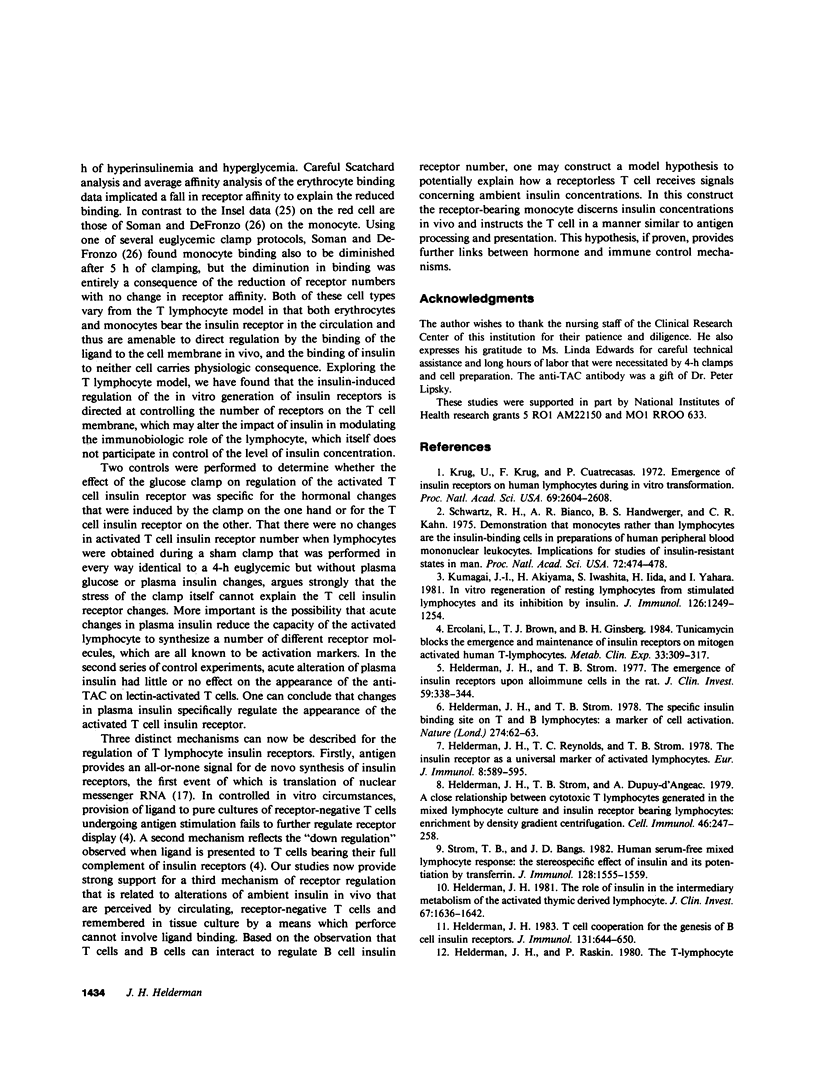
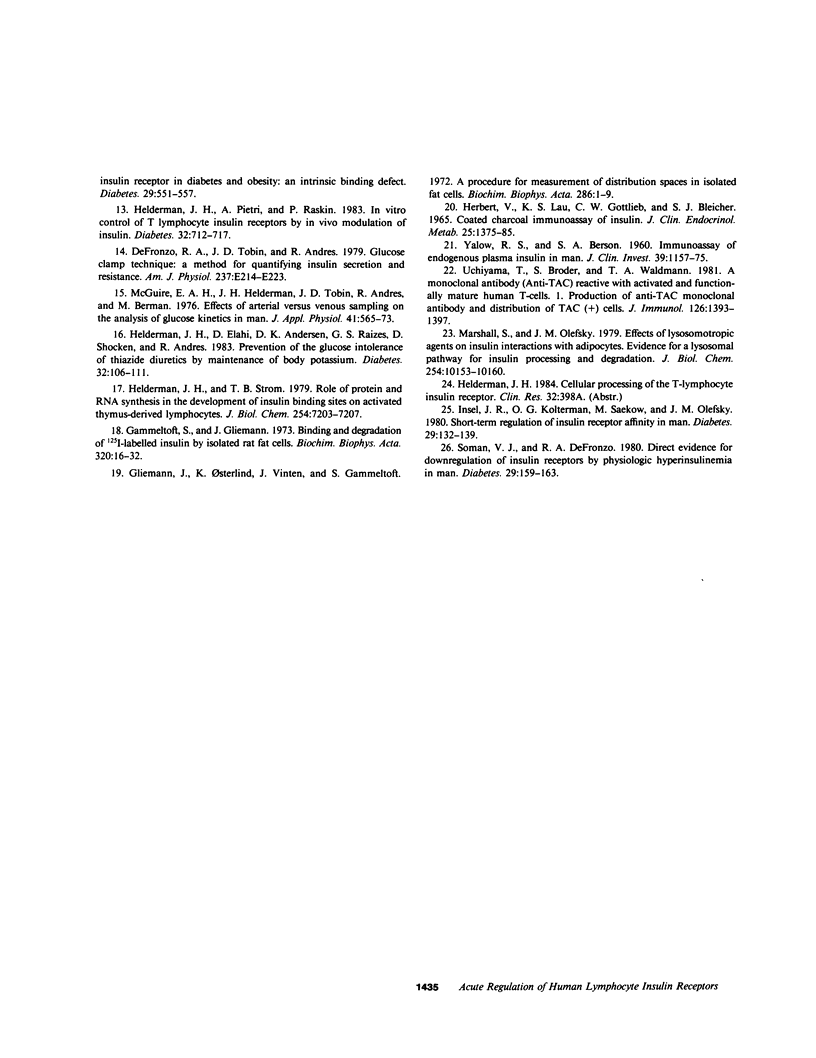
Images in this article
Selected References
These references are in PubMed. This may not be the complete list of references from this article.
- DeFronzo R. A., Tobin J. D., Andres R. Glucose clamp technique: a method for quantifying insulin secretion and resistance. Am J Physiol. 1979 Sep;237(3):E214–E223. doi: 10.1152/ajpendo.1979.237.3.E214. [DOI] [PubMed] [Google Scholar]
- Ercolani L., Brown T. J., Ginsberg B. H. Tunicamycin blocks the emergence and maintenance of insulin receptors on mitogen-activated human T lymphocytes. Metabolism. 1984 Apr;33(4):309–316. doi: 10.1016/0026-0495(84)90189-6. [DOI] [PubMed] [Google Scholar]
- Gammeltoft S., Gliemann J. Binding and degradation of 125I-labelled insulin by isolated rat fat cells. Biochim Biophys Acta. 1973 Aug 17;320(1):16–32. doi: 10.1016/0304-4165(73)90161-x. [DOI] [PubMed] [Google Scholar]
- Gliemann J., Osterlind K., Vinten J., Gammeltoft S. A procedure for measurement of distribution spaces in isolated fat cells. Biochim Biophys Acta. 1972 Nov 24;286(1):1–9. doi: 10.1016/0304-4165(72)90082-7. [DOI] [PubMed] [Google Scholar]
- Helderman J. H., Elahi D., Andersen D. K., Raizes G. S., Tobin J. D., Shocken D., Andres R. Prevention of the glucose intolerance of thiazide diuretics by maintenance of body potassium. Diabetes. 1983 Feb;32(2):106–111. doi: 10.2337/diab.32.2.106. [DOI] [PubMed] [Google Scholar]
- Helderman J. H., Pietri A. O., Raskin P. In vitro control of T-lymphocyte insulin receptors by in vivo modulation of insulin. Diabetes. 1983 Aug;32(8):712–717. doi: 10.2337/diab.32.8.712. [DOI] [PubMed] [Google Scholar]
- Helderman J. H., Raskin P. The T lymphocyte insulin receptor in diabetes and obesity: an intrinsic binding defect. Diabetes. 1980 Jul;29(7):551–557. doi: 10.2337/diab.29.7.551. [DOI] [PubMed] [Google Scholar]
- Helderman J. H., Reynolds T. C., Strom T. B. The insulin receptor as a universal marker of activated lymphocytes. Eur J Immunol. 1978 Aug;8(8):589–595. doi: 10.1002/eji.1830080810. [DOI] [PubMed] [Google Scholar]
- Helderman J. H. Role of insulin in the intermediary metabolism of the activated thymic-derived lymphocyte. J Clin Invest. 1981 Jun;67(6):1636–1642. doi: 10.1172/JCI110199. [DOI] [PMC free article] [PubMed] [Google Scholar]
- Helderman J. H., Strom T. B., Dupuy-D'Angeac A. A close relationship between cytotoxic T lymphocytes generated in the mixed lymphocyte culture and insulin receptor-bearing lymphocytes: enrichment by density gradient centrifugation. Cell Immunol. 1979 Sep 1;46(2):247–258. doi: 10.1016/0008-8749(79)90414-3. [DOI] [PubMed] [Google Scholar]
- Helderman J. H., Strom T. B. Emergence of insulin receptors upon alloimmune T cells in the rat. J Clin Invest. 1977 Feb;59(2):338–344. doi: 10.1172/JCI108646. [DOI] [PMC free article] [PubMed] [Google Scholar]
- Helderman J. H., Strom T. B. Role of protein and RNA synthesis in the development of insulin binding sites on activated thymus-derived lymphocytes. J Biol Chem. 1979 Aug 10;254(15):7203–7207. [PubMed] [Google Scholar]
- Helderman J. H., Strom T. B. Specific insulin binding site on T and B lymphocytes as a marker of cell activation. Nature. 1978 Jul 6;274(5666):62–63. doi: 10.1038/274062a0. [DOI] [PMC free article] [PubMed] [Google Scholar]
- Helderman J. H. T cell cooperation for the genesis of B cell insulin receptors. J Immunol. 1983 Aug;131(2):644–650. [PubMed] [Google Scholar]
- Herbert V., Lau K. S., Gottlieb C. W., Bleicher S. J. Coated charcoal immunoassay of insulin. J Clin Endocrinol Metab. 1965 Oct;25(10):1375–1384. doi: 10.1210/jcem-25-10-1375. [DOI] [PubMed] [Google Scholar]
- Insel J. R., Kolterman O. G., Saekow M., Olefsky J. M. Short-term regulation of insulin receptor affinity in man. Diabetes. 1980 Feb;29(2):132–139. doi: 10.2337/diab.29.2.132. [DOI] [PubMed] [Google Scholar]
- Krug U., Krug F., Cuatrecasas P. Emergence of insulin receptors on human lymphocytes during in vitro transformation. Proc Natl Acad Sci U S A. 1972 Sep;69(9):2604–2608. doi: 10.1073/pnas.69.9.2604. [DOI] [PMC free article] [PubMed] [Google Scholar]
- Kumagai J., Akiyama H., Iwashita S., Iida H., Yahara I. In vitro regeneration of resting lymphocytes from stimulated lymphocytes and its inhibition by insulin. J Immunol. 1981 Apr;126(4):1249–1254. [PubMed] [Google Scholar]
- Marshall S., Olefsky J. M. Effects of lysosomotropic agents on insulin interactions with adipocytes. Evidence for a lysosomal pathway for insulin processing and degradation. J Biol Chem. 1979 Oct 25;254(20):10153–10160. [PubMed] [Google Scholar]
- McGuire E. A., Helderman J. H., Tobin J. D., Andres R., Berman M. Effects of arterial versus venous sampling on analysis of glucose kinetics in man. J Appl Physiol. 1976 Oct;41(4):565–573. doi: 10.1152/jappl.1976.41.4.565. [DOI] [PubMed] [Google Scholar]
- Schwartz R. H., Bianco A. R., Handwerger B. S., Kahn C. R. Demonstration that monocytes rather than lymphocytes are the insulin-binding cells in preparations of humah peripheral blood mononuclear leukocytes: implications for studies of insulin-resistant states in man. Proc Natl Acad Sci U S A. 1975 Feb;72(2):474–478. doi: 10.1073/pnas.72.2.474. [DOI] [PMC free article] [PubMed] [Google Scholar]
- Soman V. R., DeFronzo R. A. Direct evidence for downregulation of insulin receptors by physiologic hyperinsulinemia in man. Diabetes. 1980 Feb;29(2):159–163. doi: 10.2337/diab.29.2.159. [DOI] [PubMed] [Google Scholar]
- Strom T. B., Bangs J. D. Human serum-free mixed lymphocytes response: the stereospecific effect of insulin and its potentiation by transferrin. J Immunol. 1982 Apr;128(4):1555–1559. [PubMed] [Google Scholar]
- Uchiyama T., Broder S., Waldmann T. A. A monoclonal antibody (anti-Tac) reactive with activated and functionally mature human T cells. I. Production of anti-Tac monoclonal antibody and distribution of Tac (+) cells. J Immunol. 1981 Apr;126(4):1393–1397. [PubMed] [Google Scholar]
- YALOW R. S., BERSON S. A. Immunoassay of endogenous plasma insulin in man. J Clin Invest. 1960 Jul;39:1157–1175. doi: 10.1172/JCI104130. [DOI] [PMC free article] [PubMed] [Google Scholar]



